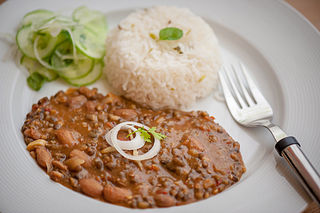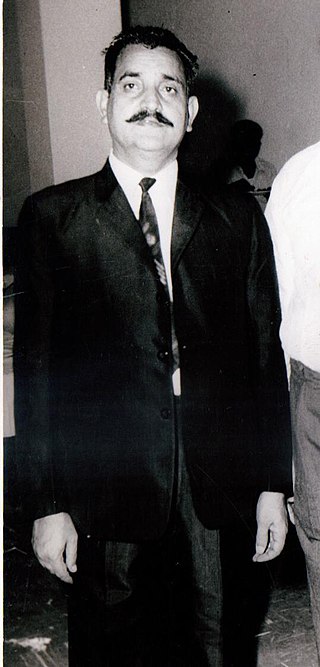
Chicken tikka masala is a dish consisting of roasted marinated chicken chunks in a spiced sauce. The sauce is usually creamy and orange-coloured. The dish was popularised by cooks from India living in Great Britain and is offered at restaurants around the world.

Pakistani cuisine can be characterized as a blend of regional cooking styles and flavours from across South, Central and Western Asia. Pakistani cuisine is influenced by Persian, Indian, and Arab cuisine. The cuisine of Pakistan also maintains certain Mughal influences within its recipes and cooking techniques. Pakistan's ethnic and cultural diversity, diverse climates, geographical environments, and availability of different produce lead to diverse regional cuisines.

Punjabi cuisine is a culinary style originating in the Punjab, a region in the northern part of South Asia, which is now divided in an Indian part to the east and a Pakistani part to the west. This cuisine has a rich tradition of many distinct and local ways of cooking.

Butter chicken, traditionally known as murgh makhani, is an Indian dish originating in Delhi. It is a type of curry made from chicken with a spiced tomato and butter (makhan) sauce. Its sauce is known for its rich texture. It is similar to chicken tikka masala, which uses a tomato paste.

Tandoori chicken is a dish made from chicken marinated in yogurt and spices and roasted in a tandoor, a cylindrical clay oven. The dish is now popular worldwide. The modern form of the dish was popularized by the Moti Mahal restaurant in New Delhi, India in the late 1940s.

A dhaba is a roadside restaurant in the Indian subcontinent, primarily across Pakistan and northern India. They are on highways, generally serve local cuisine, and also serve as truck stops. They are most commonly found next to petrol stations, and most are open 24 hours a day.

Chicken tikka is a chicken dish popularised in the Indian subcontinent popular in India, Bangladesh, Pakistan and the United Kingdom. It is traditionally small pieces of boneless chicken baked using skewers on a brazier called angeethi or over charcoal after marinating in Indian spices and dahi (yogurt)—essentially a boneless version of tandoori chicken. The word tikka is a Persian word, meaning "bits" or "pieces". It is also a chicken dish served in Punjabi cuisine. The Kashmiri version of the dish, however, is grilled over red-hot coals, and does not always contain boneless pieces. The pieces are brushed with ghee at intervals to increase its flavour, while being continuously fanned. It is typically eaten with green coriander and tamarind chutney served with onion rings and lemon, or used in preparing an authentic chicken tikka masala.

Daryaganj is a neighbourhood of Delhi inside the walled city of Old Delhi. The "darya" refers to the river Yamuna which was just outside the walled city. Daryaganj is one of the three sub-divisions and also the administrative headquarters of the Central Delhi District. It starts at Delhi Gate, at the edge of Netaji Subhash Road, which goes towards Red Fort.

Tandoori masala or tandoori sauce is a mixture of spices specifically for use with a tandoor, or clay oven, in traditional cooking in the Indian subcontinent. The specific spices vary somewhat from one region to another but typically include: garam masala, garlic, ginger, onion, cayenne pepper, and sometimes other spices and additives. The spices are often ground together with a pestle and mortar.
Bukhara is a restaurant at The Luxury Collection ITC Maurya Hotel in New Delhi, India. It was established in 1977.

Dal makhani is a dish originating in Punjab region. A relatively modern variation of traditional lentil dishes, it is made with urad dal and other pulses, and includes butter and cream.

Shahi paneer or Paneer Rajwadi or Chhena Rajwadi or Raajsi Chhena is a preparation of chhena or paneer, native to the Indian subcontinent, consisting of a thick gravy of cream, tomatoes and Indian spices.
Awadhi cuisine is a cuisine native to the Awadh region in Northern India and Southern Nepal. The cooking patterns of Lucknow are similar to those of Central Asia, the Middle East, and Northern India and western India with the cuisine comprising both vegetarian and non-vegetarian dishes. The Awadh region has been influenced by Mughal cooking techniques, and the cuisine of Lucknow bears similarities to those of Central Asia, Kashmir, Punjab and Hyderabad. The city is also known for its Nawabi foods.
Moti Mahal is a restaurant chain founded in Delhi, India. Founded after the partition of India in 1947, the Moti Mahal in Delhi was founded by Kundan Lal Gujral, Kundan Lal Jaggi and Thakur Das Magu as one of the first restaurants to introduce Punjabi cuisine and North Indian cuisine to the rest of the world such as tandoori chicken, paneer makhani, dal makhani, and butter chicken.

Malaysian Indian cuisine, or the cooking of the ethnic Indian communities in Malaysia, consists of adaptations of authentic dishes from India, as well as original creations inspired by the diverse food culture of Malaysia. Because the vast majority of Malaysia's Indian community are of South Indian descent, and are mostly ethnic Tamils who are descendants of immigrants from a historical region which consists of the modern Indian state of Tamil Nadu and Sri Lanka's Northern Province, much of Malaysian Indian cuisine is predominantly South Indian inspired in character and taste. A typical Malaysian Indian dish is likely to be redolent with curry leaves, whole and powdered spice, and contains fresh coconut in various forms. Ghee is still widely used for cooking, although vegetable oils and refined palm oils are now commonplace in home kitchens. Before a meal it is customary to wash hands as cutlery is often not used while eating, with the exception of a serving spoon for each respective dish.

Punjabi tandoori cooking comes from the clay oven known as the tandoor. According to Macveigh [2008] the Punjab tandoor originated in the local region. It is a clay oven and is traditionally used to cook Punjabi cuisine, from the Punjab region in Pakistan and northwestern India. It is traditional to have tandoors in courtyards of homes in the Punjab to make roti, naan and tandoori chicken. In rural Punjab, it is also traditional to have communal tandoors.

Paneer makhani is an Indian dish of paneer, originating in New Delhi, in which the gravy is prepared usually with butter (makhan), tomatoes and cashews. Spices such as red chili powder and garam masala are also used to prepare this gravy.

Kundan Lal Jaggi, was an Indian chef and restaurateur based in New Delhi. Kundan Lal Jaggi is the inventor of butter chicken, and dal makhani, paneer makhani and the founder of the Moti Mahal restaurant along with his partners Kundan Lal Gujral and Thakur Das Magu in 1947 in Daryaganj, Delhi.

Monish Gujral is an Indian Columnist, Restaurateur, Chef, Author, and Food blogger, and talk show host. He is the chairman of Moti Mahal. He is a Member managing Committee, NRAI- National restaurant committee of India. He is the countries foremost food- writers and has bee columnist with leading newspapers- HT City, The Hindu and at present he is the columnist with the new Indian express. He is the first Indian chef invited to the legendary institute the cordon bleu in Paris to demonstrate Indian culinary. He has hosted many cookeries shows on television for NDTV and Doordarshan. Recently He hosted T.V serial called "Health Mange More" on FOOD FOOD channel.















